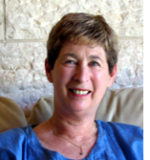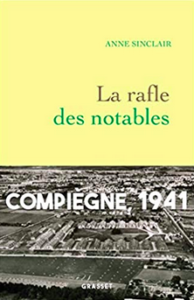By Dorothea Shefer-Vanson

MEVASSERET ZION, Israel — Anne Sinclair, noted French writer and journalist, has written extensively about the Holocaust and how it affected her family. In this book she focuses on the arrest and deportation to a prisoner camp at Compiègne of her maternal grandfather, Leonce Schwartz. He and his wife, Marguerite (Margot), resided in a comfortable apartment in a pleasant part of Paris. He owned a workshop producing lace, and their life was conducted along the lines of respectable residents of Paris, with bridge games, visits to the theatre, and a social life with friends and family.
Anne Sinclair confesses to having failed in her childhood to ask her grandparents about their experiences during the war, when Germany occupied France and persecuted Jews. In this they were aided by the French authorities, first in the area of the country under the Vichy regime, and later throughout France. To her chagrin, she did not find any record written by her grandfather of what he went through, but rests her account of what happened to him from versions written by others who underwent the same experience as well as the historical research of Serge and Beate Klarsfeld, renowned scholars of that dismal period.
First, she describes her visit to the actual site of the prison, Compiègne, which is now a military barracks, but found very little there regarding what her grandfather went through. She knew that the rafle or roundup of reputable citizens of the Jewish faith, the “notables” of the book’s title, took place on December 12, 1941, and that 743 Jewish men who were long-term residents of France and well-established within French society were arrested. They were taken from their homes at dawn that day and brought to the station to await the train taking them to the camp. Each arrest was effected by two French policemen accompanied by two Wehrmacht soldiers, and each man was allowed to take a small suitcase with a few basic articles. To their number were added another five hundred Jewish men who were arrested in the streets of Paris, with nothing but the clothes they happened to be wearing. This brought to one thousand the number of Jews arrested that day, in line with Hitler’s plan to “rid Europe of its Jews.”
 In icy cold weather the men, most of them no longer young (Leonce was 63), were made to stand and wait for many hours without food or water until they were forced into the train taking them to Compiègne, which fortunately was not a cattle train and had seats. Anne Sinclair names the prisoners who managed eventually to write a record of what they endured, and it is on these that her account of what her grandfather must have endured is based. Like many well-established and assimilated Jews, Leonce and Marguerite had remained in their home despite growing antisemitic propaganda and laws introducing the forced registration and restricted movement of Jews.
In icy cold weather the men, most of them no longer young (Leonce was 63), were made to stand and wait for many hours without food or water until they were forced into the train taking them to Compiègne, which fortunately was not a cattle train and had seats. Anne Sinclair names the prisoners who managed eventually to write a record of what they endured, and it is on these that her account of what her grandfather must have endured is based. Like many well-established and assimilated Jews, Leonce and Marguerite had remained in their home despite growing antisemitic propaganda and laws introducing the forced registration and restricted movement of Jews.
Late at night the train reached Compiègne, a few miles from Paris, where the prisoners were beaten and force-marched to the camp which consisted of a few brick walls and bare earth on which the exhausted prisoners had no option but to lie. There were three separate camps there, one for French political prisoners, one for Russian prisoners of war, and one for Jews – which was where Leonce was. The conditions in the Jewissh camp were worse than those in the others, with no possibility of receiving letters or packages, terrible sanitary conditions, and starvation rations. Occasionally, the prisoners in the other camps would share some of their food with the Jewish prisoners, and eventually iron bedsteads with thin mattresses were provided for the Jewish prisoners. The glass in the windows was broken, letting in the cold winter air; the walls topped by barbed wire provided precious little shelter from the elements. As was the case in all concentation camps, prisoners had to stand for hours during roll-call and endure the beatings and insults of the guards. The filth and lack of hygiene in the camp led to outbreaks of disease and infestations of vermin, lice and fleas. Some of the detainees were medical doctors and did what they could to ease the pain and distress of the others, but without medicines or food there was little they could do. A handful of prisoners considered to be gravely ill were released or hospitalized.
With the passage of time the prisoners’ physical state deteriorated, they lost weight and their physical and mental condition brought many of them to the verge of insanity. Some of them were deported to the main French holding camp at Drancy and thence to Auschwitz, Many of those arrested with Leonce were distinguished intellectuals, members of leading French families, and men who had fought for France in WWI; the camp at Compiègne was termed by one of its inmates, Jean-Jacques Bernard, “the camp of slow death.”
For a long time Leonce’s wife Marguerite had no news of what had happened to her husband or where he had been taken, as she tried desperately to trace his whereabouts. She eventually found out where he was and joined others making their way to Compiègne. Anne Sinclair imagines her grandfather trying to maintain some kind of cleanliness and self-respect despite the dire conditions in which he was forced to live. Prisoners played bridge or gave lectures on subjects regarding which they were knowledgeable, and this helped to maintain some kind of morale. Many, especially doctors, tried to help and support one another to the best of their ability, even though the treatment they received at the hands of the Nazis sought to reduce them to the level of beasts.
Leonce was imprisoned at Compiègne for three months, and was freed by being sent to hospital because he was considered to be very ill – as was the case with several other inmates after the long months of starvation and abuse. The camp at Compiègne was later disbanded, and many prisoners were sent to Drancy and Auschwitz in accordance with the Nazi plan to exterminate the Jews of Europe, as agreed at the meeting of senior Nazis at Wannsee in March 1942.
Wearing the uniform of a nurse, Marguerite found Leonce in the hospital and managed to commandeer an ambulance and take him to Paris. Anne Sinclair is not in possession of the exact facts of his escape, but surmises that this is what happened, and that subsequently Leonce and Marguerite managed to remain hidden in France till the end of the war. Leonce died at his home in Paris on May 16, 1945, eight days after the armistice, having lived to be reunited with his son, Anne Sinclair’s father, who had been on missions in the Near East on behalf of the Free French forces during the war.
Reading this book takes the reader on a harrowing journey to a time and place which it seems impossible to believe occurred. One would like to think that such inhumane treatment of one human being by another could not have existed in what was one of the most civilized countries of the world, but it did, and we must be grateful to Anne Sinclair for putting the raw facts before us so graphically. We must never forget.
*
Dorothea Shefer-Vanson is an author and freelance writer based in the Jerusalem suburb of Mevasseret Zion, Israel. She may be contacted via dorothea.shefer@sdjewishworld.com